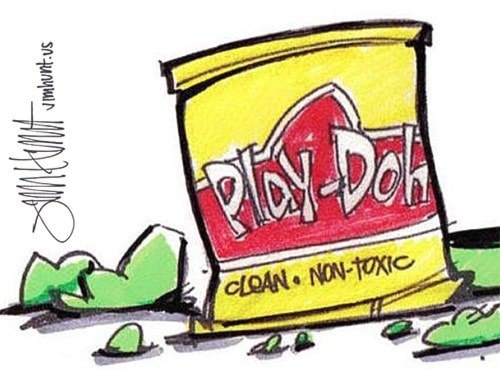During a cleaning spree a few days ago I found some unopened Play-Doh in the back of a cupboard that had been in there for years. I immediately opened the lid and took a whiff. It still had that divine nostalgic smell I’ve loved for as long as I can remember. I took the familiar modelling compoud out of it’s container and smooshed it around with my hands, creating shapes and figures before putting the lid back on and placing it on our kitchen counter.
When my 12 year old daughter came home from school she saw it and reacted almost exactly the way I had. She opened it up, took a sniff and instinctively played with it as she told me about her day. When my 15 year old son got home he did the same thing. Neither one of them asked me where it came from or why it was in the kitchen, they automatically goofed around with it, molding it into different creations and letting their imaginations take over.
I asked them if they remembered playing with it when they were younger and of course they did. I also remembered it from when I was a kid.
“They had Play-Doh way back then?” Daisy asked.
“Yes,” I said. “We didn’t have the electronics you kids have nowadays, but we definitely had this.”
Sam went on the laptop to Google it. “It’s been around since 1956,” he said amazed. “Before you were even born, Mom.” That actually surprised me as well and we proceeded to read more.
It turned out it was originally a wallpaper cleaner in the 1930s when homes were heated with coal and the messiness of soot was created. It wasn’t until the mid 50s that it became something kids played with - and it was quite by accident that happened at all.
The product which was originally composed of flour, water, salt, boric acid, and mineral oil was first manufactured in Cincinnati by Kutol Soap Products and after many years of doing decent business their sales decreased drastically after World War II when oil and gas furnaces became popular, as well as the introduction of washable vinyl wallpaper,
On the verge of bankruptcy the sister-in-law of one of the owners randomly read a magazine article in 1955 recommending wallpaper cleaner to make Christmas ornaments. She took a big can of it to the community nursery school she ran and the children rolled out the doughish compound and cut it into shapes with cookie cutters to make festive decorations. She then suggested a reworking of the substance to her brother-in-law so it could be marketed as a toy. What a brilliant idea.
Adding the colours red, blue and yellow, the revamped product was originally named Kutol’s Rainbow Modeling Compound. That didn’t sound fun enough so they renamed it Play-Doh and introduced it to the Cincinatti Board of Education in 1956 where it was used in elementary schools for arts and crafts.
In 1957 it was shown on the popular children’s television show Captain Kangaroo. Bob Keeshan who played the Captain presented it for free, agreeing to take 2% of the profits in lieu of advertsing dollars since they couldn’t afford to pay for ads at the time. After that it was seen on Ding Dong School and Romper Room and by 1958, the sales of Play-Doh had reached nearly $3 million.
The product the struggling owners had been barely selling for .34 cents per can was suddenly selling for $1.50 and they couldn’t keep up with the tremendous demand.
It started getting exported to other countries and the sales kept increasing. General Mills eventually bought the company and then Hasbro. Their surprise hit product continued to evolve and sales continued to soar.
It’s been 60 years since Play-Doh was first introduced to children and the recipe has been tinkered with and improved upon several times. It’s now selling in over 75 countries, has been inducted into the National Toy Hall of Fame, and the Toy Industry Association has it listed as one of the 100 most memorable and most creative toys of the twentieth century.
Many consider it one of the most beloved toy products ever created - quite an extraordinary success for a nearly defunct substance once intended to wash walls. And quite a coincidence we discovered this interesting bit of toy history after a rare cleaning spree.
I now have an added appreciation for Play-Doh, which I already loved, and I will be adding it to my list for Santa.
Lori Welbourne is a syndicated columnist. She can be contacted at LoriWelbourne.coma
